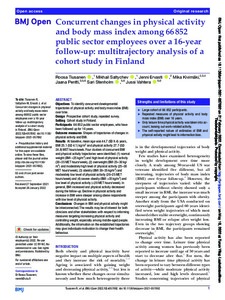Concurrent changes in physical activity and body mass index among 66 852 public sector employees over a 16-year follow-up: Multitrajectory analysis of a cohort study in Finland
Kivimäki Mika; Ervasti Jenni; Vahtera Jussi; Pentti Jaana; Tiusanen Roosa; Stenholm Sari; Saltychev Mikhail
https://urn.fi/URN:NBN:fi-fe2022081154208
Tiivistelmä
Objectives
To identify concurrent developmental trajectories of physical activity and body mass index (BMI) over time.
Design
Prospective cohort study, repeated survey.
Setting
Cohort study in Finland.
Participants
66 852 public sector employees, who have been followed up for 16 years.
Outcome measures
Shapes of trajectories of changes in physical activity and BMI.
Results
At baseline, mean age was 44.7 (SD 9.4) years, BMI 25.1 (SD 4.1) kg/m2 and physical activity 27.7 (SD 24.8) MET hours/week. Four clusters of concurrent BMI and physical activity trajectories were identified: (1) normal weight (BMI <25 kg/m2) and high level of physical activity (30–35 MET hours/week), (2) overweight (BMI 25–30 kg/m2) and moderately high level of physical activity (25–30 MET hours/week), (3) obesity (BMI 30–35 kg/m2) and moderately low level of physical activity (20–25 MET hours/week) and (4) severe obesity (BMI >35 kg/m2) and low level of physical activity (<20 MET hours/week). In general, BMI increased and physical activity decreased during the follow-up. Decline in physical activity and increase in BMI were steeper among obese respondents with low level of physical activity.
Conclusions
Changes in BMI and physical activity might be interconnected. The results may be of interest for both clinicians and other stakeholders with respect to informing measures targeting increasing physical activity and controlling weight, especially among middle-aged people. Additionally, the information on the established trajectories may give individuals motivation to change their health behaviour.
Kokoelmat
- Rinnakkaistallenteet [19207]
